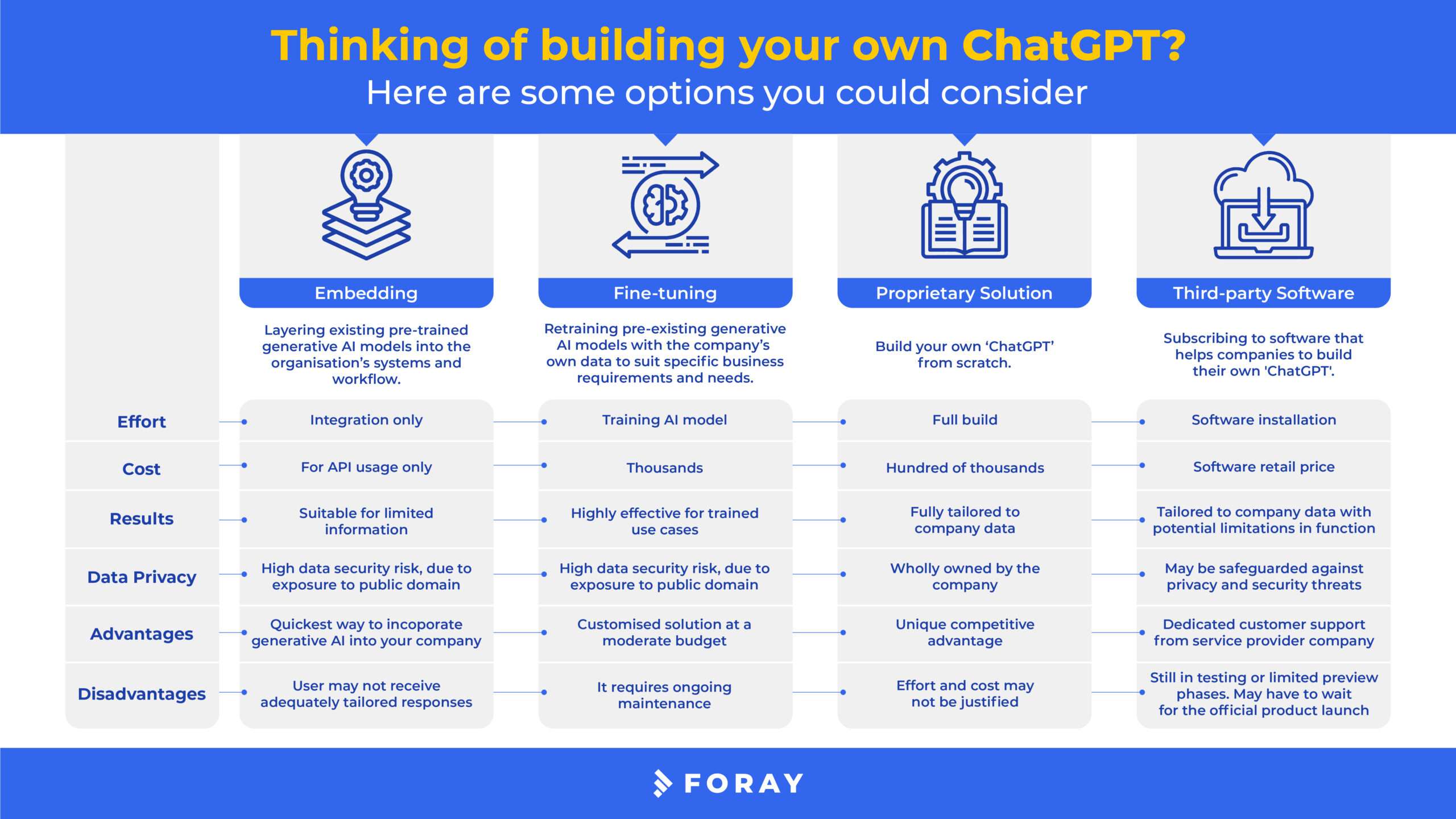
This is the third part of a three part series article.
- First article | Generative AI & The Effects on Businesses
- Second article | Top 5 (Generative) AI Risks for Businesses and How to Address Them Successfully
Following on from our last article on the risks of Generative AI and how to navigate them, today’s issue will focus on how to enlist AI to your fullest advantage.
With 64% of enterprises reporting a significant increase in productivity resulting from AI implementation, there is a clear benefit to using the technology in businesses. So how do you, as directors, ensure that your organisation and people keep up with the wave of change? Read on as we will discuss everything you need to know about preparing your organisation for AI transformation and empowering your people to use Generative AI responsibly.
(In the article, I talk about AI and Generative AI; in general, the points on AI are fully applicable to Generative AI)
Key Components An AI Policy Must Have
Organisations need a comprehensive AI policy in place to ensure ethical AI usage. Employees should be fully aware of the responsibilities of AI use and understand how to maximise it while navigating the risks without jeopardising the business. Here are a few critical components below that the policy should outline.
1. The Rationale for The AI Policy
The AI policy should declare that the purpose of the text is to set rules and best practices for the responsible use of AI. It may state that the AI usage policy is intended to encourage the innovative use of AI technologies while reducing the risk of purposeful, inadvertent, or unethical misuse, potential prejudices, inaccuracy, and information security breach.
2. Clear Do’s and Don’ts
Be clear on how the AI tools will be incorporated into the company’s existing policies, such as those governing discrimination, privacy, and inappropriate behaviour. These should be articulated as explicit and detailed guide rails on what employees can or cannot do using Generative AI. An example of such a clause would be a strict ban on using AI to create damaging, offensive, or discriminatory content against employees, partners, or clients.
In particular, the policy needs to specify which external tools can be used and how for Generative AI.
3. An Overview Of The Data Privacy Regulations
All existing government and corporate data privacy standards should be complied with, outlined in the policy and regularly updated; this includes, but it’s not limited to, Malaysia PDPA. Sensitive or personal data should be encrypted or anonymised, and employees should avoid disclosing information about colleagues or customers. Most importantly, a contingency or crisis management plan should also be in place so that teams can systematically respond should there be data or cybersecurity breaches.
4. Clear Guidelines to Ensure Data Precision
AI tools may lack accuracy, as the system often cannot provide the source of its output. As a result, it may be challenging to verify the relevance of the sources used. Hence, to ensure the integrity and credibility of data sources, there should also be guidelines and processes wherein facts, data or insights must be verified before the AI project to maintain accuracy and avoid misrepresentation.
5. Clear Intellectual Property Guidelines
As with data protection rules, existing intellectual property policies must also be respected. Your AI policy must address the misuse of AI-generated content that may be an infringement of intellectual property rights or blatant plagiarism at worst.
Should you build your own ChatGPT?
ChatGPT poses a security threat in its current iteration because data on the platform inherently would be publicly accessible. Additionally, its general purpose may not fit your company’s specific needs. Therefore, building one’s own ‘ChatGPT’ can be recommended, especially when data confidentiality is a priority, or you want to leverage your accumulated enterprise knowledge.
While building a bespoke Generative AI solution can incur high costs on initial investment and training, multiple examples in the market prove its utility. For instance, Bloomberg announced that they are integrating a ChatGPT-like tool, aptly named BloombergGPT, that answers readers’ questions.
If you’re wondering how you can have your own ChatGPT, here are 3 (plus one) options you may consider:
-
Embedding
How this works: Layering existing pre-trained Generative AI models into your organisation’s systems and workflow.
Advantages of embedding
✔ Quickest way to incorporate Generative AI into your organisation.
✔ Requires the least amount of effort since the software is already ready to use.
✔ Least expensive option as you only need to cover the costs of the API usage.
Disadvantages of embedding
✖ Pre-existing Generative AI model not precisely trained on your company’s data.
✖ Users may not receive adequately tailored responses.
✖ May risk confidential data being disclosed due to ChatGPT being public domain.
-
Fine-tuning
How this works: Retraining pre-existing Generative AI models with your business’ data to suit specific business requirements and needs.
Advantages of fine-tuning
✔ Generative AI model is modified to perform for business objectives optimally.
✔ Highly effective for specific use cases.
✔ Users may receive responses that are closer to what is required.
Disadvantages of fine-tuning
✖ Require more time and costs than embedding—for Generative AI model retraining.
✖ Requires ongoing maintenance.
✖ May risk confidential data being disclosed due to ChatGPT being public domain.
-
Proprietary Solution
How this works: Building your own ‘ChatGPT’ from scratch.
Advantages of a proprietary solution
✔ The company wholly owns this Generative AI solution.
✔ Generated responses are tailored to suit your company’s demands.
✔ A strategic advantage before tailored Generative AI solutions become commonplace.
✔ Confidential data is safeguarded against privacy and security threats.
Disadvantages of a proprietary solution
✖ Require the most cost, time and effort compared to other options.
✖ Effort and costs may not be justified.
-
Third-party Software
How this works: Subscribing to software that helps companies to build their own ‘ChatGPT’.
For example, Microsoft is currently working with new GPT integration ventures. Some of these plans include Copilot, which aims to operate as your own personal productivity assistant within the Microsoft 365 ecosystem.
(Technically, this is embedding, but it comes partially prebuilt and with a trusted label on it)
Advantages of third-party software
✔ Lower costs and effort for a tailored Generative AI solution
✔ Dedicated customer support from the service provider company
✔ Confidential data may be safeguarded against privacy and security threats.
Disadvantages of third-party software
✖ At the time of writing, most tools are still in testing or limited preview phases.
✖ Businesses with immediate needs may have to wait for the official product launch.
In an overview, the chart below also compares these options vis-à-vis the key considerations company executives should consider when integrating Generative AI into a business.
What Roles You Need in Your Organisation

The next step in incorporating Generative AI in your company is appointing a steering team to ensure the execution aligns with your strategic vision. The team should comprise of:
The next step in incorporating Generative AI in your company is appointing a steering team to ensure the execution aligns with your strategic vision. The team should comprise of:
- Board Directors at large: Generative AI is set to change many businesses drastically and how businesses work, like when IT and the Internet came about. Therefore, all board directors should have a basic understanding of Generative AI.
- Board Technology Committee or IT Director: Provide oversight on all AI and Generative AI initiatives.
- Chief Information Officer / Chief Data & Analytics Officer: Provide oversight on overall technology direction and execution for AI initiatives.
- AI Ethics / Data Protection Officer: Define and implement ethical and legal boundaries in the use of AI and data.
- Business Heads: Ultimately, technology is there to serve the business. Business heads should be accountable for AI-related initiatives and drive them for the company’s benefit.
- Technical team: Provide technical in-depth expertise on traditional cloud and data science skills. This team should also have know-how in prompt engineering, which is the process of carefully crafting and fine-tuning inputs given to an AI model to get the most accurate and valuable output.
Empowering Your People to Use Generative AI Responsibly

First and foremost, communicate the AI vision to the team.
It is critical to have open conversations with employees about AI. This includes discussing how AI will affect their work and how they may prepare for the changes. It also entails being open and honest about the risks and benefits of the technology. Don’t forget that your workforce may be savvier than you when it comes to Generative AI.
Intentionally address and reduce biases and prejudices.
AI training data may reflect unconscious human biases, which amplify existing discrimination of all forms. Therefore, organisations must step up to actively eliminate these biases. (For example: Have frequent audits of the AI-generated outputs by diverse groups of stakeholders, guidance and training on algorithmic biases etc.). This also applies when using Generative AI models (LLMs) that a vendor has trained.
Train and upskill employees to prepare for the future.
Training current employees with essential skill sets is important for successful AI implementation. Companies will need a strategy for reconfiguring roles and preparing staff to be more adaptive to AI use. Generative AI will be highly pervasive, with many aspects of jobs becoming automated or supported.
Key Takeaways for Board Directors: Embracing AI And Moving Forward
While it may be tempting for leaders to delegate the implementation of Generative AI to their IT staff or ignore it, senior executives and board members must spearhead the responsible, thoughtful and purposeful use of AI throughout the organisation.
We have also seen strong indications of how Generative AI positively impacts productivity and efficiency, which are critical in helping companies reap revenue growth, net promoter scores and employee motivation.
Although there is no one-size-fits-all approach to incorporating AI, organisations must own a solid set of corporate principles and a broad team to offer varying perspectives to be future-ready.
With that, we have arrived at the end of our series on Generative AI and businesses. We hope these insights have helped you better understand all things AI-related and how to tailor them to fit your business objectives.
In addition, here are some of my favourite resources for your reading pleasure:
- Article: 6 best practices to develop a corporate use policy for Generative AI
- Article: Does your company need a policy for AI like ChatGPT?
- Article: Make sure Generative AI policies cover intellectual property
- Repository: MIT Technology Review to stay updated on the latest news about AI.
Finally, as always, if you have any challenges, comments or questions regarding managing the use of Generative AI right now, write to me at vittorio@forayadvisory.com!

 4.8
4.8 














